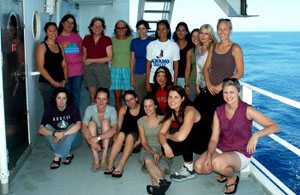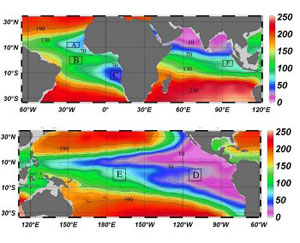Oxygen-poor regions of tropical oceans are expanding as the oceans warm, limiting the areas in which predatory fishes and other marine organisms can live or enter in search of food, according to a major ongoing marine exploratory project. The phenomenon could cut overall marine biodiversity.
The Collaborative Research Centre programme – Climate: Biogeochemistry Interactions in the Tropical Ocean – funded by the German Research Foundation is working in close cooperation with the University of Kiel, and researchers at the Scripps Institution of Oceanography at the University of California San Diego.

Janet Sprintall (standing, fourth from left) on board CLIVAR cruise R/V Roger Revelle.
The project aims to help scientists understand the interactions between climate and biogeochemistry on a quantitative basis as global warming progresses. Now, team member Lothar Stramma of the Leibniz Institute of Marine Sciences in Kiel and Scripps’ Janet Sprintall, and NOAA scientist Gregory Johnson and Volker Mohrholz from the Institute for Baltic Sea Research in Warnemünde, Germany, have analysed a database of ocean oxygen measurements in the tropics at a depth of 300 to 700 metres. They have found that oxygen levels have declined during the past fifty years. The ecological impacts of this increase could have substantial biological and economical consequences, the researchers suggest.
We found the largest decline in the tropical northeast Atlantic, explains Stramma, whereas the changes in the eastern Indian Ocean were much less pronounced. The researchers concede there is no way of knowing whether or not global warming alone is to blame. There are several natural processes that act on shorter timescales that might reduce oxygen levels, they point out. Sprintall adds that oxygen-poor areas could migrate into coastal areas via currents along the west coast of continents.

Mean dissolved oxygen concentrations in the world’s oceans at a depth of 400 metres (Image courtesy of AAAS/Science)
The width of the low-oxygen zone is expanding deeper but also shoaling toward the ocean surface,” said Sprintall, a specialist in observing changes of fluxes in ocean properties such as heat distribution. The team publishes details of their work in the 2nd May issue of Science.
Much of the recent data comes from oxygen sensors added to the 150 Argo floats – a worldwide network of 3000 temperature and salinity sensors. Sprintall says that the value of data from just 150 Argo floats suggests that even greater insights into shifting oxygen levels across the world’s oceans could be obtained if more floats were fitted with oxygen sensors.
Further reading
Science, 2008, 320, 655-658
http://dx.doi.org/10.1126/science.1153847
IFM-GEOMAR homepage
http://www.ifm-geomar.de/index.php?id=6&L=1
The ARGO project homepage
http://www.jimo.ucsd.edu/research/projects/current/A_theme/argo.htm
Suggested searches
climate change
global warming